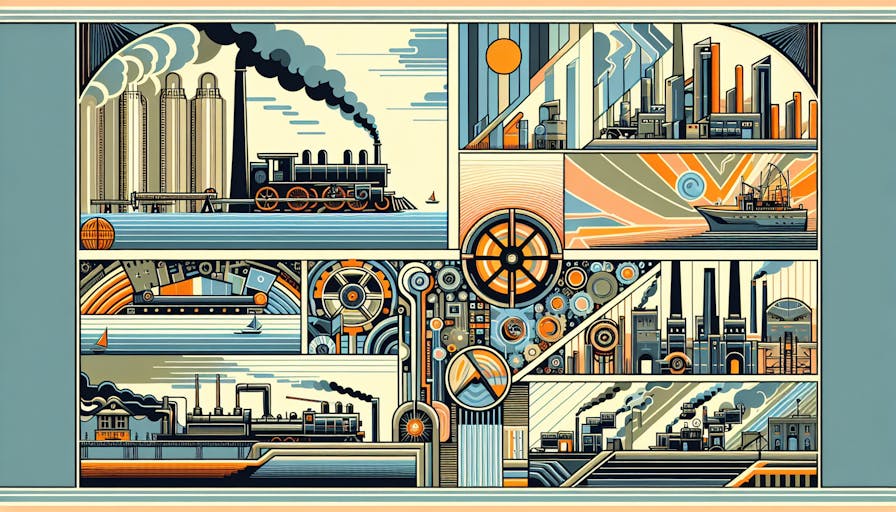Origins of the Industrial Revolution and Early Innovations
The onset of the Industrial Revolution marked a pivotal turn in human history, bringing about monumental changes in industry, technology, and society. This section delves into the early stages of this era, focusing on the initial sparks of industrialization and the significant breakthroughs in the textile industry.
The Dawn of Industrialization
The Industrial Revolution traces its roots to mid-18th century England, a period characterized by a surge in technological innovations that would eventually spread across the world. This transformative epoch began subtly, with modest advancements in farming and production methods, but it rapidly gained momentum, laying the groundwork for modern industry and manufacturing processes.
One of the principal causes of the industrial revolution was the burgeoning demand for goods, which existing manufacturing methods could no longer satisfy. The response was a burst of creativity and invention that led to the development of machines capable of mass production, altering the course of production and labor forever.
The textile industry, in particular, was at the forefront of this transformation. Britain’s rich supply of coal and iron ore, coupled with its colonial empire and access to raw materials like cotton, positioned it as the epicenter of these early industrial changes. The innovations during this period not only fueled industry but also set the stage for the widespread social and economic shifts that would follow.
Textile Industry Breakthroughs
The textile sector was the first to experience the profound impact of industrialization. Pioneering inventions revolutionized how textiles were produced, transitioning from manual labor to mechanized processes. The industrial revolution timeline is punctuated by a series of key inventions in this field:
| Invention | Year | Description |
|---|---|---|
| Flying Shuttle | 1733 | Enhanced the weaving process, allowing wider fabrics to be woven faster |
| Spinning Jenny | 1764 | Enabled a single worker to spin multiple spindles of thread simultaneously |
| Water Frame | 1769 | Harnessing water power, it produced stronger threads for weaves |
| Spinning Mule | 1779 | Combined aspects of the Spinning Jenny and Water Frame, improving thread quality |
Data sourced from World History Encyclopedia
These breakthroughs led to the establishment of the first factories, specifically designed to house these new machines and streamline production. The power loom, emerging a little later, further accelerated the production of cotton fabric, marking the transition from manual craftsmanship to factory-based production.
By the early 19th century, Britain had emerged as the world’s leading producer of cotton textiles due to these technological advancements. The nation’s ability to mass-produce textiles not only reshaped its own economy but also had far-reaching effects on global trade and industrial practices.
The early innovations of the Industrial Revolution laid the foundation for a rapidly changing world. The advancements in the textile industry, specifically, are emblematic of the greater shifts in production and labor that defined the era. These changes are further explored through their effects on the industrial revolution and the transformation of industrial revolution working conditions.
The Expansion of Industrialization
The Industrial Revolution marked a pivotal moment in history as it reshaped society with the transition from manual labor to mechanized manufacturing. From its early beginnings in Britain, the revolution would soon spread across the globe, transforming economies and societies in its wake.
Spreading Beyond Britain
The wave of industrialization that began in Britain in the 18th century did not remain confined to its shores. By the late 18th and early 19th centuries, the transformative power of industrialization began to permeate beyond Britain, reaching the European continent and the New World. In 1793, Englishman Samuel Slater opened a textile mill in Pawtucket, Rhode Island, effectively transplanting British technology—including Eli Whitney’s cotton gin—to American soil (History](https://www.history.com/news/industrial-revolution-cities)). This event marked the beginning of the spread of industrialization to the United States, which would then see its own [Industrial Revolution after the Civil War, culminating in a significant period of urbanization and a shift towards large-scale factory production.
The Rise of Factories
The advent of the factory system was a defining hallmark of the Industrial Revolution. Factories, equipped with innovative machinery like the water frame and spinning jenny, became the new hubs of production. The first steam-powered textile mill appeared in Manchester in 1780, heralding the beginning of industrial mechanization (World History Encyclopedia). This shift from cottage industry to factory-based manufacturing revolutionized the way goods were produced and had a profound impact on labor and social structures.
The concentration of production in factories led to a significant migration of the workforce from rural to urban areas. The Industrial Revolution instigated major social and economic transformations, especially in terms of labor and living conditions. The Factory Act of 1833 in the UK was a response to these changes, marking an early step towards labor reforms by limiting children’s workdays to a maximum of 12 hours (World History Encyclopedia). The industrialization of agriculture in the early 20th century further diminished the need for labor in rural farming areas, prompting young adults to seek job opportunities in urban factories. This, coupled with the Great Migration of African American tenant farmers, reshaped the workforce dynamics and contributed to urban growth (History).
The Industrial Revolution’s influence on society extends far beyond its technological achievements. It altered the very fabric of life, affecting everything from family structures to social mobility. As we delve deeper into the industrial revolution timeline, we can observe how these shifts laid the foundation for the modern world, setting a precedent for future economic and social reforms.
Advancements in Technology
The technological advancements during the Industrial Revolution were pivotal in shaping modern industry and society. This period saw significant innovations in steam power, iron and coal production, and transportation infrastructure.
Steam Power Revolution
The revolution of steam power marked a cornerstone in the industrial revolution timeline. The introduction of steam engines, particularly those improved by James Watt in the late 18th century, enabled factories to operate independently of water streams and move to more advantageous locations, fostering the decentralization of industry. The first steam-powered textile mill established in Manchester in 1780, as reported by the World History Encyclopedia, exemplifies the profound impact steam power had on manufacturing productivity and the overall industrial landscape.
Iron and Coal Developments
With the surge in demand for steam power came an increased need for coal, which in turn propelled advancements in the iron industry due to the necessity for machinery and rails. Notable developments, such as the Bessemer process introduced around 1850, revolutionized the way iron was produced and refined, making it more efficient and cost-effective. These innovations laid the groundwork for the expansive railway systems and the machinery that would become ubiquitous in the industrialized world.
Transportation and Infrastructure Growth
The expansion of the canal and railway systems was instrumental in supporting the transportation of raw materials and manufactured goods. The growth in transportation infrastructure facilitated by steam power and advancements in iron production allowed for quicker and more reliable movement of goods and resources. This not only increased the efficiency of trade but also contributed to the economic expansion during this era.
| Year | Advancement | Impact |
|---|---|---|
| 1780 | First steam-powered textile mill | Initiated mechanization of textile industry |
| Late 18th century | Introduction of James Watt’s steam engine | Decentralization of factories |
| 1850 | Bessemer process for refining iron | Enabled mass production of steel |
These technological advancements are integral to the industrial revolution definition and are crucial for understanding the effects of the industrial revolution. They not only transformed industries but also brought about significant social and economic impacts, including profound shifts in workforce dynamics and living conditions. The technology of the Industrial Revolution set the stage for the modern era and remains a testament to human ingenuity and the relentless pursuit of progress. To delve deeper into the causative factors of this transformative period, explore our article on the causes of the industrial revolution.
The Industrial Revolution was not only a period of technological advancements but also a time of profound social and economic changes. The timeline of the industrial revolution is marked by significant shifts in urbanization, workforce dynamics, and labor movements, each of which had lasting implications.
Urbanization and Living Conditions
The rise of industrial cities transformed the landscape of the United Kingdom and, subsequently, the world. By 1801, approximately 20% of the UK’s population resided in towns and cities with populations of at least 10,000. This urban proportion grew to two-fifths by mid-century, and by 1901, three-quarters of the population lived in urban areas, with half in cities of 20,000 or more Britannica.
| Year | Urban Population (%) | Cities of 10,000+ | Cities of 20,000+ |
|---|---|---|---|
| 1801 | 20% | – | – |
| 1851 | 40% | – | – |
| 1901 | 75% | 66% | 50% |
Industrialization’s effect on living conditions was profound, with rapid urbanization leading to overcrowded and unsanitary conditions in burgeoning cities. The influx of workers into urban areas resulted in densely packed slums characterized by pollution, disease, and inadequate infrastructure. To understand how these conditions came to be, one can explore causes of the industrial revolution.
Shifts in Workforce Dynamics
The industrialization process brought about significant changes in the composition and dynamics of the workforce. The textile industry, a cornerstone of the Industrial Revolution, was instrumental in propelling this shift. As the sector expanded, it drew a steady influx of labor from rural areas to cities, where factories offered new employment opportunities Britannica.
The urban workforce was diverse, comprising men, women, and children, all of whom had to adapt to the rigorous demands of factory work. This represented a stark departure from the agrarian lifestyle that had previously dominated society. The effects of such a transition on the workforce are further detailed in the effects of the industrial revolution.
Labor Reforms and Movements
As the industrial workforce swelled, so too did the push for improvements in working conditions. The often dismal and hazardous environments faced by workers fueled a series of labor reforms and movements. These aimed to address issues like long working hours, inadequate wages, and the exploitation of child labor.
The collective efforts of workers to organize and advocate for their rights led to the formation of trade unions and the eventual passing of legislation to protect laborers. The reforms that took shape during this time laid the groundwork for modern labor laws and workers’ rights. For a closer look at the working conditions that necessitated these reforms, visit industrial revolution working conditions.
The industrial revolution timeline is punctuated by these social and economic impacts, which continue to resonate in today’s society. The transition to an urban-centric world, the evolution of the workforce, and the strides made in labor rights are just a few examples of the revolution’s far-reaching consequences.
The Global Reach
The Industrial Revolution was a pivotal era that transcended its British origins, ultimately influencing global industrial practices, shaping economies, and altering societies. In this section, we will explore the diffusion of industrialization across the Atlantic to the United States and throughout Europe, examining key advancements and their implications.
Industrialization in the United States
Industrialization in the United States gained momentum in the late 18th century following Britain’s lead. In 1793, Samuel Slater opened the first American textile mill in Pawtucket, Rhode Island, utilizing technology similar to that developed in England, including innovations like Eli Whitney’s cotton gin History. This marked the beginning of the United States’ own industrial saga, often referred to as the Second Industrial Revolution.
The period after the Civil War, particularly the second half of the 19th century, saw an escalated shift from small shop production to large factory systems. This transformation spurred urbanization as the burgeoning factories became magnets for millions seeking employment, including a significant influx of immigrants.
The advancement of agricultural industrialization in the early 20th century mechanized farming practices, reducing labor needs in rural areas. Consequently, young adults from farming families migrated to urban factories, contributing to the Great Migration of African American tenant farmers and others to cities mainly in the Midwest History.
| Event | Year | Description |
|---|---|---|
| Samuel Slater’s Textile Mill | 1793 | First American textile mill established in Rhode Island |
| Civil War Ends | 1865 | Paved the way for industrial expansion in the US |
| Agricultural Mechanization | Early 20th Century | Reduced rural labor, leading to urban migration |
For more detailed insight into the transformation of work during this period, visit industrial revolution working conditions.
European Industrial Advancements
Europe was a close witness to Britain’s industrial burgeoning and soon embarked on its own journey of industrial development. By the early 19th century, Britain had emerged as the leading cotton textile producer globally due to significant innovations and mechanization within the industry World History Encyclopedia.
The transition towards machine-based manufacturing that began in the latter half of the 18th century in Britain saw the mechanization of the textile industries, advancements in iron-making techniques, and increased use of refined coal. These developments led to the creation of urban jobs and overall economic growth, pulling thousands from low-productivity agricultural labor to more productive urban manufacturing Lumen Learning.
Europe’s technological leaps focused on the spinning process, with inventions like the flying shuttle, spinning jenny, water frame, and spinning mule revolutionizing textile manufacturing. This innovation wave ushered in the factory system and set the stage for a more widespread industrial expansion Lumen Learning.
| Invention | Inventor | Year | Impact |
|---|---|---|---|
| Flying Shuttle | John Kay | 1733 | Increased weaving speed and demand for yarn |
| Spinning Jenny | James Hargreaves | 1764 | Improved spinning efficiency |
| Water Frame | Richard Arkwright | 1769 | Enabled water-powered spinning |
| Spinning Mule | Samuel Crompton | 1779 | Combined spinning jenny and water frame features |
These European industrial advancements not only transformed the continent’s economic landscape but also left an indelible mark on the world stage. To understand the origins and context of these changes, delve into causes of the industrial revolution and examine the broader effects of the industrial revolution on society.
The Timeline of Key Events
The industrial revolution timeline is a series of key events that collectively describe the epic transformation of society through industrialization. This timeline highlights the major inventions, legislative acts, and shifts from cottage industries to factories, culminating in the second wave of industrial advancements.
Major Inventions and Acts
The Industrial Revolution was marked by significant inventions and acts that fundamentally changed the manufacturing landscape. Beginning in Britain in the mid-1700s, groundbreaking innovations such as the spinning jenny, invented around 1764, paved the way for mechanized production (source).
| Year | Invention/Act |
|---|---|
| 1764 | Invention of the Spinning Jenny |
| 1785 | Power Loom Patented |
| 1833 | Factory Act of 1833 |
| 1856 | Bessemer Process for Steel Production |
These inventions accelerated the pace of work and led to the drafting and passing of several legislative acts aimed at regulating the burgeoning industries and protecting workers, such as the Factory Act of 1833 which sought to improve conditions for children working in factories.
From Cottage to Factory
The progression from home-based, manual labor to centralized factory systems was a significant characteristic of the Industrial Revolution. The shift was fueled by the advent of efficient machinery that could not be housed in small workshops, leading to the rise of the factory as the hub of production.
In the span of just a few decades, the industrial revolution working conditions changed dramatically, with workers migrating from rural areas to industrial centers to work in large factories that dominated the landscape.
The Second Industrial Wave
By the early 19th century, industrialization had spread from Britain to other parts of Europe and the United States, marking the beginning of the second industrial wave. This period was characterized by further advancements in technology, such as the Bessemer process for refining iron, introduced in 1856, and the development of extensive telegraph networks that revolutionized communication.
| Year | Event |
|---|---|
| Early 1800s | Spread of Industrialization to Europe and the U.S. |
| 1856 | Introduction of the Bessemer Process |
| Late 1800s | Expansion of Telegraph Networks |
The second industrial wave continued to evolve until the outbreak of World War I in 1914, which marked the end of this era as war economies shifted the focus away from industrial production. The effects of the industrial revolution were far-reaching, leaving an indelible mark on social, economic, and cultural aspects of life.
The Industrial Revolution is a testament to human ingenuity and the quest for progress. By understanding the causes of the industrial revolution and its timeline, students can better appreciate the complexity and impact of this pivotal period in history.









2 comments
Comments are closed.